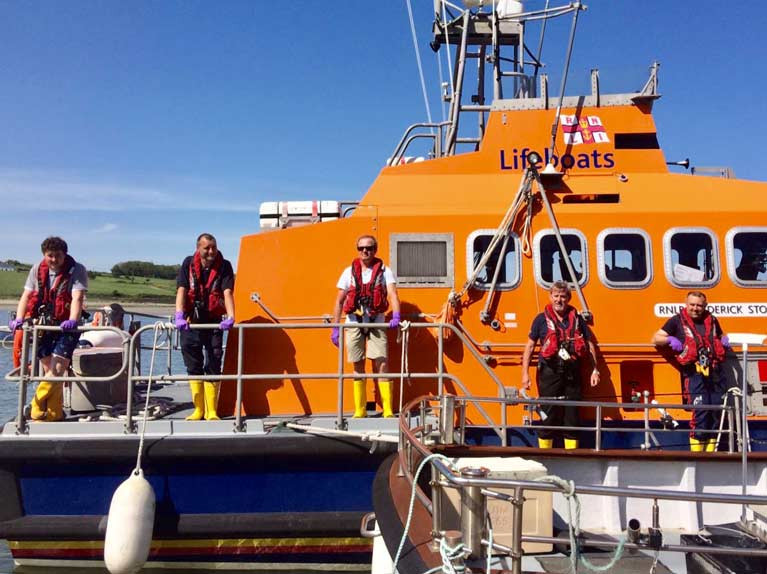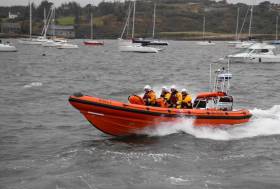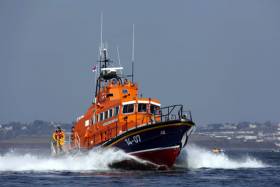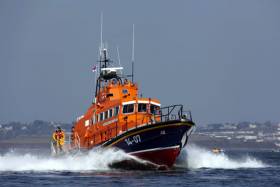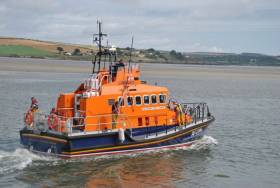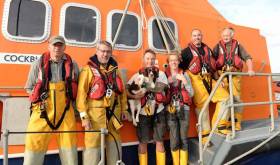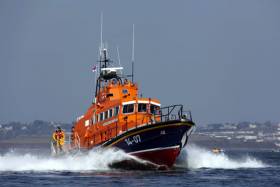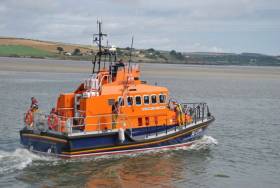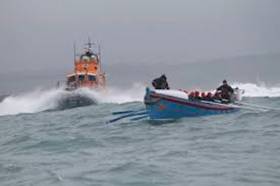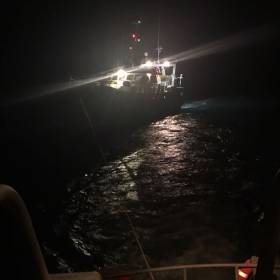Displaying items by tag: Courtmacsherry
Courtmacsherry RNLI Lifeboat in Call Out to Swimmers in Difficulty off Inchydoney Island, West Cork
The Courtmacsherry All-Weather Trent Class RNLI Lifeboat was called out at 2.10 pm this afternoon to go to the aid of swimmers who had got into difficulty off Virgin Mary’s Bank in Inchydoney Island, West Cork.
Under Coxswain Sean O Farrell and a crew of five, the Courtmacsherry Lifeboat was underway very quickly, under the Station’s new COVID-19 Launch protocols and immediately made its way at top speed to the area of the causalities. Also mobilised was the local Irish Coastguard Unit from Castlefreke, the Coastguard Rescue 115 Helicopter from Shannon and the Local HSE Ambulance. Four persons were swimming together when two got into difficulty. The others made the shoreline and raised the alarm by immediately contacting the rescue services.
Thankfully the two swimmers in difficulty were later able to get ashore where they were assessed by the rescue services, following a very traumatic ordeal. All four were hugely appreciative of the responses of the Rescue Services.
Commenting on this afternoon’s callout, the Courtmacsherry RNLI Voluntary LPO Vincent O Donovan thanked all the Lifeboat crewmembers and Station Officers for ensuring a safe callout today. He commented that “It was also vital that the call for help to the Rescue services was made as quickly as possible as vital minutes can be so important in all rescues”.
The crew on board this afternoon’s call out were Coxswain Sean O Farrell, Mechanic Stuart Russell and crew members Tadgh McCarthy, Dara Gannon and Evin O Sullivan. Of note was that five other crewmembers were quickly at the station in order to give any help required. Attached is a picture of the Lifeboat crew after returning to base.
Busy Weekend For West Cork Lifeboats In Baltimore & Courtmacsherry
Following last Thursday’s launch to a sailing dinghy aground on an island near Baltimore Harbour, the local RNLI crew were called out twice on Sunday (22 September), with the first to other boat aground in the harbour.
The inshore lifeboat was on scene in a matter of minutes after they were notified that the 14m sailing boat had run up on rocks at the harbour’s edge.
Volunteer crew set up a tow line to return the vessel to deeper water and, once it was checked over for damage, the lifeboat towed the yacht head to wind to let its crew set their sails.
Baltimore’s inshore lifeboat launched again at 3.36pm to assist a RIB with five people on board which broke down and was at anchor off Castle Point, near Schull Harbour.
However, while en route the lifeboat was stood down after word came through that the RIB’s occupants had managed to get themselves under way.
Elsewhere, in West Cork, Courtmacsherry’s all-weather lifeboat launched on Saturday evening (21 September) as bad weather unfolded to rescue a surfer in difficulty off Inchydoney.
As the lifeboat was speeding across Clonakilty Bay to the reported location, its crew were informed that the surfer had managed to get ashore safe and well.
Deputy launching authority Diarmuid O’Mahony praised those on shore who called for help for their quick alert: “Vital minutes today could have been so important in sea conditions that were very poor.
“I also want to commend all the volunteer crew who responded so quickly in coming to the lifeboat station in the knowledge that they were going to face some mountainous seas and difficult conditions off the coast.”
As previously reported, Crosshaven RNLI also launched yesterday to two sailors whose catamaran dinghy capsized in Cork Harbour yesterday evening.
Courtmacsherry RNLI was among the search and rescue agencies who responded yesterday morning (Thursday 8 August) to reports that a man had taken ill during a diving expedition to the wreck of the Lusitania.
As reported by The Irish Times, it is suspected that the diver, one of a group of eight, developed the bends as he returned to the surface from the wreck site some 18km off the Old Head of Kinsale.
The Naval Service vessel LÉ George Bernard Shaw diverted from patrol in the area and sent a team to bring the casualty on board, from where he was airlifted to hospital.
Later the casualty was transferred from Cork University Hospital to University Hospital Galway, which has a decompression unit.
As the emergency operation wound down, Courtmacsherry RNLI’s all-weather Trent class lifeboat Frederick Stormy Cockburn received another Mayday call, to a 30ft yacht in difficulty off the Seven Heads coast.
The lifeboat was at the scene within 20 minutes and proceeded to tow the stricken vessel back to the safe surrounds of Courtmacsherry Pier.
Commenting on the morning’s callouts, Courtmacsherry lifeboat operations manager Brian O'Dwyer praised all the crew for their professionalism and fast response.
Elsewhere, shortly after 1pm, Crosshaven lifeboat volunteers were called to a medical evaluation from Spike Island in Cork Harbour.
According to Crosshaven RNLI, crew member Aoife Dinan performed casualty care until paramedics arrived, having been brought to the Island by the Port of Cork RIB.
The Irish Community Air Ambulance also landed on the island along with Crosshaven Coast Guard.
“Very sadly, the male casualty, who was a foreign visitor, was declared deceased,” said press officer Jon Mathers. “Our sympathies are with the family of the deceased man; may he rest in peace.”
Courtmacsherry Lifeboat Crew Rescue Kitesurfer In Difficulty
Courtmacsherry RNLI’s all-weather Trent class lifeboat Frederick Stormy Cockburn was called out just after midday yesterday (Saturday 22 June) to go to the aid of a kitesurfer who had got into difficulties off Harbour View in Courtmacsherry Bay.
Under coxswain Micheal O'Donovan and a crew of six, the lifeboat was underway within minutes following the call by onlookers who saw the person in difficulty offshore with his kite.
Within 15 minutes the lifeboat crew had located the casualty and took the person from the water and into the safe surrounds of the lifeboat.
The kitesurfer was very relieved to be rescued and was assessed and brought safely ashore.
Conditions at sea were windy with a strong swell in the area, which is popular with windsurfers and kitesurfers.
Deputy launching authority Dermot O’Mahony said: “It was a fast callout today and I would like to praise the crew for assembling so quickly this morning.
“We would also like to commend the people on the shore who acted rapidly in alerting the rescue services when they observed what was happening, as every minute is important in these situations.”
On today's callout with O’Donovan were mechanic Stuart Russell and crew Kevin Young, Dave Philips, Austin McKenna, Conor Dullea and Dean Hennessey.
Courtmacsherry Lifeboat Rescues Fishing Vessel With Two Onboard
#Lifeboats - The RNLI's all-weather lifeboat from Courtmacsherry rescued a fishing vessel which got into difficulty today with two people onboard yesterday afternoon (Monday 21 January).
The lifeboat was called out at 1.15pm to go to the aid of the 40ft vessel which had got into difficulties off the Seven Heads peninsula in West Cork and required assistance.
Under coxswain Sean O'Farrell and a crew of six, the lifeboat was quickly away and made its way at full speed to the area of the casualty.
Conditions at sea were fresh, with winds blowing Force 6 as the cold snap of weather finally hit the South Coast.
The lifeboat reached the casualty at 1.45pm and immediately took the boat, which had two crew members, in tow.
After a slow tow in lumpy conditions, the lifeboat and the casualty arrived to the safe surrounds of the Courtmacsherry Pontoon at 3.15pm.
This is the second callout so far of 2019 and voluntary lifeboat operations manager Brian O’Dwyer praised all the crew who responded so quickly today on a cold January Monday.
The crew on yesterday’s callout were coxswain Sean O’Farrell, mechanic Stuart Russell and crew members Mark Gannon, Dara Gannon, Ken Cashman, Austin McKenna and Evin O’Sullivan.
Brian further commented that there were four more crew that turned up quickly: “I am really proud that 11 crew members reacted swiftly today in the help of local fishermen who required assistance at sea.”
#RNLI - Courtmacsherry RNLI’s all-weather lifeboat was called out at 5.20pm on Friday evening (24 August) when a dog was reported to be stranded on remote rocks at the base of a steep cliff, near the Fuschia Walk in Courtmacsherry Bay.
Frederick Storey Cockburn — under coxswain Sean O’Farrell, with mechanic Colin Bateman and crew members Donal Young, Conor Dullea, Paul McCarthy and Enda Boyle — was launched immediately and reached the cliff face in 15 minutes.
The potential danger was that people would attempt to climb down the steep cliff in an attempt to get to the dog. There were also reasonable gusty winds at sea that evening, which made conditions tricky for working near the cliff face.
Two lifeboat volunteers manoeuvred into the rocky creek on an inflatable rescue dinghy and were able to persuade the black and white setter to get on board.
Once safely on board the lifeboat, the dog was given a prime seat as the lifeboat prepared to head for home.
Minutes later, a pleasure boat that was nearby had experienced engine failure and requested assistance.
The lifeboat immediately went to the aid of the 21ft pleasure boat — plus its skipper and his own dog — and took it in tow back to the safe surrounds of Courtmacsherry Pontoon by 6.45pm, where there was an emotional reunion with the owner of the stranded setter.
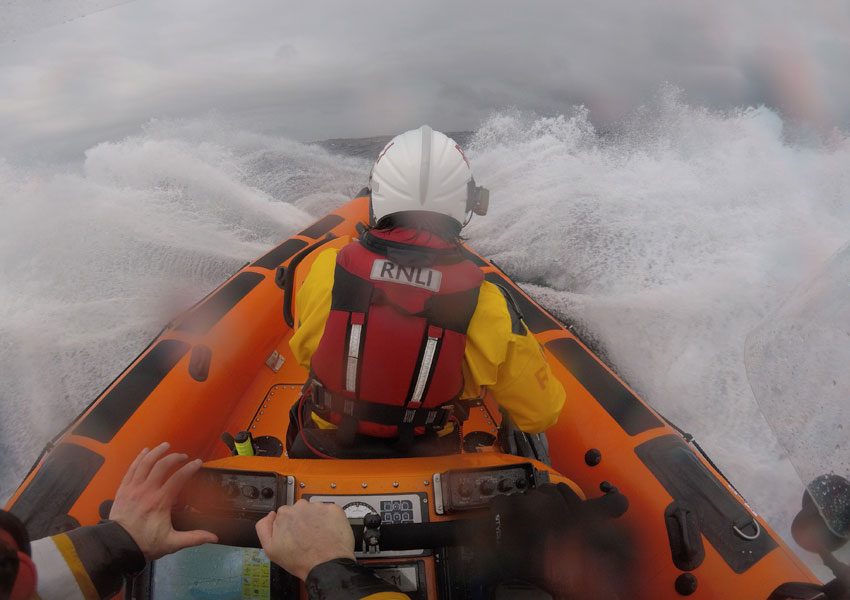
More recently, Bundoran RNLI in Co Donegal responded yesterday evening (Sunday 26 August) to a false alarm with good intent after three stand-up paddle boarders were reported to be in difficulty near Mullaghmore, Co Sligo.
The lifeboat, helmed by Killian O’Kelly was launched around 5.20pm minutes and immediately made its way to the scene amid difficult weather conditions, with heavy rain and reduced visibility.
Once on scene, the crew observed that the experienced trio, who had been competing in a downwind race from Mullaghmore to Bundoran, were not in any difficulty.
“They were all wearing lifejackets and carrying a method of communication,” O’Kelly said. “While this was a false alarm with good intent, we would like to commend the member of the public who raised the alarm as conditions at sea were not good at the time. We would always much rather launch to find all is well than not launch at all.
“With a lot of visitors enjoying the long Northern Bank Holiday weekend here in Bundoran, we would remind everyone planning a visit to the beach or the sea, to always respect the water.
“Plan your activity in advance, always wear a lifejacket and always carry a means of communication. Should you get into difficulty, call 999 or 112 and ask for the coastguard.”
#RNLI - Courtmacsherry RNLI’s all-weather lifeboat Frederick Storey Cockburn was called out at 9pm on Friday night (3 August) to go to the aid of a 36ft yacht adrift some 18 miles off the Old Head of Kinsale in West Cork.
Under coxswain Sean O’Farrell and a crew of six, the lifeboat was underway within minutes, travelling at its top speed of 25 knots, and located the vessel at 10.30pm.
The yacht had been on passage from the Isle of Wight when it lost power and its crew sent out a distress message to the Irish Coast Guard.
The lifeboat immediately attached a tow rope to the casualty and proceeded to tow the yacht, which had four crew onboard, slowly and safely back to Courtmacsherry Harbour.
Friday night’s callout was the first to use the Courtmacsherry station’s early warning message Siren, which will now be part of every callout in order to alert people in the water nearby or the public in the village that a lifeboat call is in progress.
Lifeboat operations manager Brian O’Dwyer said: “It’s been the busiest six weeks for many a year and many thanks to all the volunteers at the station for always putting the rescue of others ahead of all their other interests.”
The busy time continued over the August Bank Holiday weekend as the Courtmacsherry lifeboat was called at 12.20pm n Saturday afternoon (4 August) to a pleasure cruiser in difficulty off the Seven Heads peninsula.
The casualty boat, with three on board, had fouled its propellers and lost power while on passage to Castletownshend, having departed Crosshaven the previous day.
Once again under coxswain Sean O’Farrell, the lifeboat towed the stricken vessel back to the safe surrounds of the Courtmacsherry Pier Pontoon.
#RNLI - Courtmacsherry RNLI rescued six people yesterday afternoon (Sunday 22 July) when their 20ft RIB dive boat got into difficulties at the Old Head of Kinsale.
The all-weather lifeboat under coxswain Kevin Young and a crew of six launched at 1.20pm on a busy Sunday to the casualty vessel at the western Hole Open.
Weather conditions were good with a reasonable wind blowing.
The lifeboat reached the distressed RIB within 15 minutes and immediately took the boat under tow and away from the danger of the rocky shoreline.
All arrived back in the safe surrounds of Courtmacsherry Harbour at 3.20pm, and the lifeboat refuelled and returned to its mooring in readiness for any further callout.
#RNLI - For more than 100 years, the crews of Courtmacsherry Harbour Lifeboat Station have laid a wreath over the site of RMS Lusitania.
In Courtmacsherry Bay, the old British Royal Navy watch tower of the Seven Heads peninsula is the closest point of land to the Lusitania tragedy at 11.2 nautical miles.
Courtmacsherry Harbour is also home to a one of the earliest established lifeboat stations in Ireland, founded in 1825, and at the time of the Lusitania tragedy located at Barry’s Point in Courtmacsherry.
On 7 May 1915, the Lusitania, a British Cunard line ocean liner, was on passage from New York when she was torpedoed and sunk by a German U-boat south of Courtmacsherry Bay, with the loss of 1,201 lives.
The Courtmacsherry RNLI volunteer lifeboat crew was alerted to the tragedy and due to the fine weather that day, the sails were of no use, so they rowed the Kezia Gwilt lifeboat to the scene of the sinking.
The sea was strewn with the dead, some with lifebelts on, others holding on to pieces of rafts. The volunteers of the Kezia Gwilt spent six hours on scene, taking bodies from the water.
In 2015, the present lifeboat crew and residents of Courtmacsherry village, many of whom are related to the original 1915 lifeboat crew who were called to service, staged a re-enactment of that heroic row by the then lifeboat crew to the site of the Lusitania.
Since that ill-fated day in 1915, the crew of Courtmacsherry RNLI annually pay tribute to those lost by laying a wreath over the wreck of RMS Lusitania.
If anyone would like the crew to lay a wreath on their behalf for those lost on the Lusitania, they can bring it to Courtmacsherry Harbour Lifeboat Station before 12.30pm on Monday 7 May.
Courtmacsherry Lifeboat Rescues Four On Trawler In Trouble
#RNLI - Courtmacsherry RNLI’s all-weather lifeboat was called out at 7pm on Saturday night (11 November) to go to the aid of an 80ft fishing boat that got into difficulties 15 miles south of the Seven Heads in West Cork.
The Trent class lifeboat, under coxswain Ken Cashman with a crew of five, launched immediately and proceeded at full speed to the distress area as the large trawler with four crew onboard sought assistance.
The stricken vessel was located by the lifeboat at 7.45pm and an immediate tow was put in place, proceeding at low speed back to the safe haven of Kinsale.
Weather conditions in the area at the time were misty with Force 3-4 winds and a strong swell.
Courtmacsherry RNLI lifeboat operations manager Brian O’Dwyer praised the crew for carrying out the rescue with great speed and professionalism.
He also thanked them and all station personnel for skipping Ireland’s important soccer battle in Copenhagen in order to help others in distress.
The crew of the lifeboat were coxswain Ken Cashman, mechanic Stuart Russell, Ciaran Hurley, Conor Dullea, Denis Murphy and Evin O’Sullivan.


























